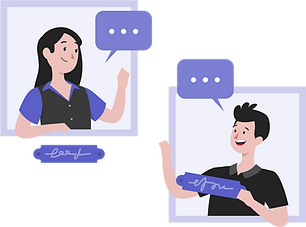



Microsoft Teams
UX & Accessibility design for D/deaf and hard of hearing (DHH) people to help them alleviate challenges caused by multitasking.
Role
UX Designer
Duration
8 months
Sponsorship
Microsoft
Type
Capstone Project
Background
Hybrid work environments have brought new challenges to ideation processes. Microsoft Teams Whiteboard offers a solution by providing a shared workspace for virtual brainstorming. However, D/deaf and hard of hearing (DHH) individuals face the challenge of multitasking when collaborating with others on this platform.
By implementing design improvements to the current platform, our goal is to mitigate these challenges by aiding meeting facilitators in organizing effective meetings, ensuring participants remain informed throughout, and enhancing the user-friendliness of captions.
D/deaf and hard of hearing (DHH)
/dɛf ənd hɑrd ʌv ˈhɪrɪŋ/ noun.
Individuals who have varying degrees of hearing loss, including those who are completely deaf as well as those who have some level of hearing ability but still experience difficulties in hearing and understanding speech.
The team
.png)
Joyce Yu
UX designer
.png)
Xing He
UX designer
.png)
Sherry Wang
UX designer

Shaun Kalweit
UX researcher
Our team collaborated closely with Microsoft Teams, particularly the accessibility team, to conduct research and develop additional features in Teams whiteboard for the DHH (D/deaf and Hard of Hearing) community.
My work included several UX design for the new features, for which I heavily engaged in research, brainstorming, and prototyping processes.
-
5 Subject Matter Expert interviews
-
7 brainstorm sessions
-
3 Co-design sessions
-
UI/UX design for the whiteboard agenda features
-
Iteration on virtual moderator and caption box features
DHH individuals face the daunting task of multitasking when attempting to collaborate using a whiteboard platform, as they must also pay attention to visual language (i.e. captions, interpreter, etc.)


How might we...
Reduce the burden of multitasking faced by DHH people in the virtual whiteboard?

Design overview
This concept specification outlines four add-on features that aim to improve the overall experience and effectiveness of brainstorming sessions.

Feature 1
Agenda templates
Have no idea of the meeting
Without an understanding of the meeting agenda before and during the meeting, it is overwhelming to continuously switch focuses - let alone an additional screen for the whiteboard session.
Design opportunity
By providing a range of customizable templates, facilitators can structure the meeting session by session including details, duration, and speaking rules. Participants are also able to keep the schedule in mind.


Feature 2
Live agenda

Too Much to Focus On
Using Whiteboard during a meeting itself is a multi-task, and it can be difficult for DHH users to know where to direct their attention. One highlighted focus at a time is recommended.
Design opportunity
Imported from templates, it aims to keep all participants on track with the overall flow of the meeting by providing real-time progress tracking.

Feature 3
Virtual moderator
Information Goes By Fast
As a result of being forced to visually multitask, DHH participants miss information. Fixed visual aids that remain available to view are appreciated for the clarification they provide.
Design opportunity
This feature leverages advanced speech recog-nition technology to provide more accurate captions. It is also able to provide visual cues to draw attention to important points.


Feature 4
Caption box
Captions are Inefficient
Inaccuracy, rigidity (i.e. fixed position), and lack of speaker differentiation in captions require much cognitive effort and eye travel to understand, sapping visual and cognitive effort.
Design opportunity
Participants have flexible options to adjust the caption and caption box to optimize readability based on their preferences during the meeting and white boarding.

Reflection
"Be Prepared for Anything"

-
Working with an underrepresented group such as D/deaf and hard of hearing participants required thorough preparation.
-
Despite consulting subject matter experts beforehand, we still encountered unexpected challenges. We faced difficulties when our ASL interpreter repeatedly experienced disruptions in the meeting. The inability of our CART captioners to access captions in Microsoft Teams was unexpected. Some insights and suggestions provided by our participants were also surprising.
-
This project taught me the importance of adapting to changing circumstances, prioritizing our target users, and avoiding assumptions.
